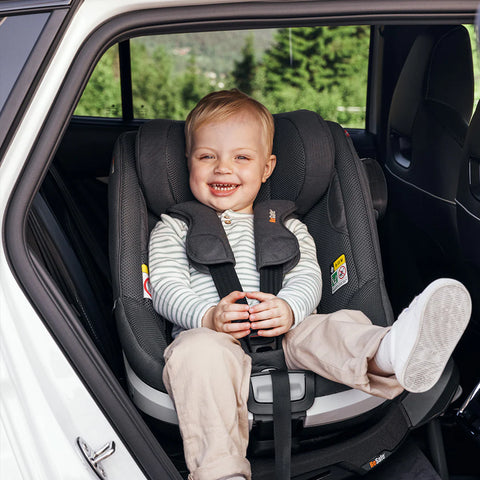Keeping your child safe in the car is every parent’s top priority, and using the right rear-facing car seat is one of the most crucial steps in ensuring their safety. Rear-facing seats are designed to offer the best protection, particularly for infants and toddlers, by significantly reducing the risk of serious injury in the event of a crash. In the UK, rear-facing car seats are mandatory for young children, and understanding the regulations and benefits can help parents make informed decisions.
In this guide, we’ll cover UK laws, safety regulations, the benefits of rear-facing car seats, and provide practical advice for choosing the best seat for your child.
UK Law and Safety Regulations for Rear-Facing Car Seats
In the UK, the law is clear about child car seat usage:
- Children must use a car seat until they are 12 years old or 135 cm tall, whichever comes first.
- Babies and toddlers must travel in a rear-facing car seat until they weigh at least 9 kg, but experts recommend keeping children rear-facing for as long as possible for maximum safety.
Key Regulations:
- R44/04 Standard: Seats approved under this regulation allow forward-facing from 9 kg, but parents are encouraged to keep their child rear-facing beyond this.
- R129 (i-Size) Standard: This newer regulation mandates that children must remain rear-facing until at least 15 months old, but extended rear-facing seats are recommended for longer use, up to 4 years old or 18 kg.
While the law sets a minimum requirement, keeping your child rear-facing beyond these limits is much safer. Studies show that rear-facing seats can reduce the risk of serious injury in crashes by up to 75% compared to forward-facing seats.

Benefits of Rear-Facing Car Seats
Why Rear-Facing is Safer:
The main benefit of a rear-facing car seat is the protection it offers to your child’s head, neck, and spine in the event of a crash. In frontal collisions, which are the most common, the impact forces are distributed across the seat, preventing the child’s head from being thrown forward.
- Infants and toddlers have weaker neck muscles and a proportionately larger head compared to their body. Rear-facing seats help to prevent serious injuries by offering more support in a crash.
- Crash test data consistently shows that rear-facing seats significantly reduce the risk of injury, especially in frontal and side-impact collisions.
Types of Rear-Facing Car Seats Available in the UK
When shopping for a rear-facing car seat, it’s important to understand the different types available to suit your child’s age, weight, and height.
1. Infant Carriers (Group 0+)
- Suitable from birth to 13 kg (approximately 12–15 months).
- Often portable and compatible with travel systems.
- Ideal for newborns but should be replaced with an extended rear-facing seat as the child grows.
2. Extended Rear-Facing Seats (Group 0+/1)
- These seats are suitable from birth to around 18 kg (approximately 4 years).
- Designed to keep children rear-facing for a longer period.
- Typically bulkier but offer more protection and can be used until the child is ready for a forward-facing seat.
3. Combination Seats (Group 1/2)
- These seats transition from rear-facing to forward-facing.
- A cost-effective solution for parents looking for a seat that grows with their child, but they may not offer the same level of protection as a dedicated extended rear-facing seat.
ISOFIX vs. Seatbelt Installation:
- ISOFIX: This system provides a safer and more secure installation, reducing the risk of incorrect fitting.
- Seatbelt Installation: A good option for cars without ISOFIX points but requires careful attention to installation.
How to Choose the Best Rear-Facing Car Seat
Here’s a checklist of key features to consider when selecting the right rear-facing car seat for your child:
1. Safety Standards
Ensure the seat complies with UK regulations like R44/04 or R129 (i-Size) for added safety and peace of mind.
2. Extended Rear-Facing (ERF)
Opt for seats that allow extended rear-facing use, ideally up to 18 kg or 105 cm in height. These seats offer significantly more protection for toddlers.
3. Adjustability
Look for seats with adjustable headrests and harnesses that can grow with your child, ensuring a comfortable and secure fit as they age.
4. Comfort Features
Seats with multiple recline positions, padded covers, and breathable fabrics can make long journeys more comfortable for your little one.
5. Size and Fit
Consider the size of the car seat and whether it will fit in your car, especially if space is limited. Some extended rear-facing seats are bulky, but newer designs offer space-saving solutions.
6. Ease of Use
Seats with a 360-degree swivel make it easier to place your child in and out of the car. Quick-release harnesses also save time while ensuring a snug fit.
Popular Rear-Facing Car Seat Models in the UK
Here are some of the top-rated extended rear-facing car seats available in the UK, perfect for keeping your child safe for longer:
1. Axkid Minikid 4
- Suitable from birth to 25 kg (approximately 6 months to 6 years).
- Features automatic headrest adjustment as your child grows.
- Designed specifically for extended rear-facing, providing maximum safety and comfort.
- Seatbelt installation.
2. BeSafe iZi Turn B I-Size
- Suitable from birth to 105 cm (approximately birth to 4 years).
- Features a 360-degree swivel, allowing for easy transitions between rear-facing and forward-facing positions.
- Equipped with advanced side impact protection and multiple recline options for enhanced comfort and safety.
- ISOFIX installation ensures a secure and straightforward fit in your vehicle.
3. Axkid Move
- Extended rear-facing seat for children up to 25 kg (approximately 6 months to 6 years).
- Affordable, offering great value without compromising safety.
- Offers side impact protection and easy installation using the car’s seatbelt.
4. BeSafe Stretch
- Allows extended rear-facing use up to 36 kg (approximately 6 months to 7 years), making it one of the longest-lasting rear-facing seats on the market.
- Extra legroom for comfort and adjustable recline positions.
- Seatbelt installation with a focus on long-term use and safety.
Safety Tips for Using a Rear-Facing Car Seat
- Proper Installation: Ensure your car seat is installed correctly, whether using ISOFIX or a seatbelt. Many local councils offer free car seat fitting checks.
- Positioning: Always place the rear-facing car seat in the back seat. It’s illegal and dangerous to use a rear-facing seat in the front if there’s an active airbag.
- Harness Positioning: The harness should fit snugly across the child’s chest, and the chest clip should sit at armpit level to prevent injury.
- Winter Clothing: Avoid dressing your child in bulky clothing, which can interfere with the fit of the harness. Use blankets over the harness instead.
Common Misconceptions about Rear-Facing Car Seats
1. Legroom Concerns
Many parents worry that their child won’t have enough legroom. However, toddlers are flexible, and most are comfortable sitting cross-legged or resting their legs on the seat back.
2. Visibility
Rear-facing seats mean you can’t see your child easily, but rear-view mirrors are a simple solution, allowing you to keep an eye on your little one without compromising safety.
3. Outgrowing the Seat
Many parents switch to forward-facing too soon. Remember, outgrowing a seat means exceeding the height or weight limit, not just turning one year old.
Cost and Affordability
Rear-facing car seats range from £100 to £400, depending on features and safety standards. While budget options are available, investing in an extended rear-facing seat ensures greater protection for longer, making it a long-term investment in your child’s safety.
Practical Tips for Parents
- Check your seat regularly for wear and tear, ensuring it remains safe and secure.
- Rotate seats within the same vehicle to accommodate siblings.
- Pack toys or car organisers to keep your child entertained on long journeys.
Conclusion
Rear-facing car seats are the safest option for infants and toddlers, and keeping your child rear-facing for as long as possible greatly reduces the risk of injury. When choosing a rear-facing car seat, consider the safety standards, features like ISOFIX and extended rear-facing capability, and make sure the seat fits your car.
Don’t wait—explore trusted brands and find the perfect rear-facing seat for your child’s safety today. For further guidance, check out local car seat fitting services or visit a retailer for expert advice.







Comments (0)
There are no comments for this article. Be the first one to leave a message!